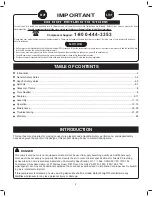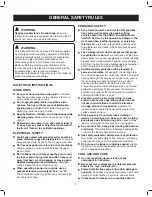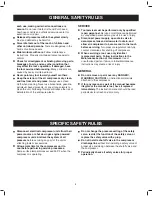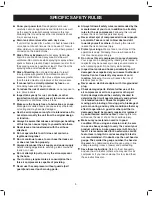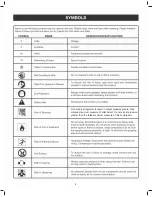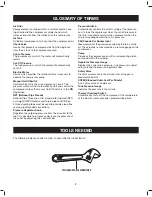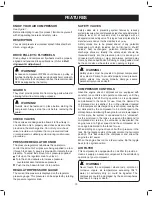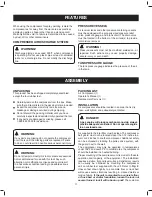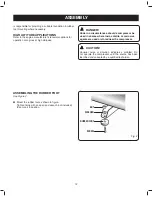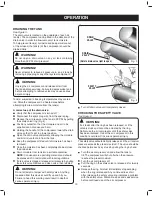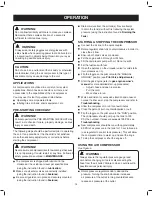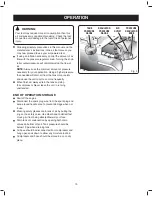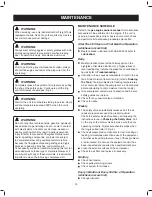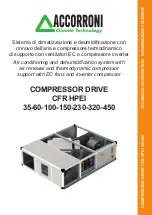
3
WARNING:
Read and understand all instructions.
Failure to
follow all instructions listed below may result in electric
shock, fire, and/or serious personal injury.
SAVE THESE INSTRUCTIONS
WORK AREA
Keep your work area clean and well lit.
Cluttered
benches and dark areas invite accidents. Floor must
not be slippery from wax or dust.
Do not operate power tools in explosive atmo-
spheres, such as in the presence of flammable
liquids, gases, or dust.
Power tools create sparks
which may ignite the dust or fumes.
Keep bystanders, children, and visitors away while
operating tools.
Distractions can cause you to lose
control.
Operate air compressor in an open area at least 18
in. away from any wall or object that could restrict
the flow of fresh air to ventilation openings.
ELECTRICAL SAFETY
Avoid body contact with grounded surfaces such as
pipes, radiators, ranges, and refrigerators.
There is an
increased risk of electric shock if your body is grounded.
Don’t expose power tools to rain or wet conditions.
Water entering a power tool will increase the risk of
electric shock.
Do not abuse the cord. Never use the cord to carry
the tool or pull the plug from an outlet. Keep cord
away from heat, oil, sharp edges, or moving parts.
Replace damaged cords immediately.
Damaged
cords increase the risk of electric shock.
When operating a power tool outside, use an
outdoor extension cord marked “W-A” or “W”.
These cords are rated for outdoor use and reduce the
risk of electric shock.
PERSONAL SAFETY
Eye protection which conforms to ANSI specifica-
tions and provides protection against flying
particles both from the FRONT and SIDE should
ALWAYS be worn by the operator and others in the
work area when loading, operating, or servicing
this tool.
Eye protection is required to guard against
flying fasteners and debris, which could cause severe
eye injury.
The employer and/or user must ensure that proper
eye protection is worn.
We recommend a Wide Vision
Safety Mask for use over eyeglasses or standard safety
glasses that provide protection against flying particles
both from the front and side. Always use eye protection
which is marked to comply with ANSI Z87.1.
Additional safety protection will be required in
some environments.
For example, the working area
may include exposure to a noise level which can lead to
hearing damage. The employer and user must ensure
that any necessary hearing protection is provided
and used by the operator and others in the work
area. Some environments will require the use of head
protection equipment. When required, the employer
and user must ensure that head protection marked to
comply with ANSI Z89.1 is used.
Stay alert, watch what you are doing, and use
common sense when operating a power tool. Do
not use tool while tired or under the influence
of drugs, alcohol, or medication.
A moment of
inattention while operating power tools may result in
serious personal injury.
Dress properly. Do not wear loose clothing or
jewelry. Contain long hair. Keep your hair, clothing,
and gloves away from moving parts.
Loose clothes,
jewelry, or long hair can be caught in moving parts.
Do not overreach. Keep proper footing and balance
at all times.
Proper footing and balance enables better
control of the tool in unexpected situations.
Use safety equipment. Always wear eye protection.
Dust mask, nonskid safety shoes, hard hat, or hearing
protection must be used for appropriate conditions.
Do not use on a ladder or unstable support.
Stable
footing on a solid surface enables better control of the
tool in unexpected situations.
TOOL USE AND CARE
Do not exceed the pressure rating of any
component in the system.
Never use this compressor to inflate low pressure
objects (i.e. toys, footballs, etc.).
Protect material lines and air lines from damage or
puncture.
Keep hose and power cord away from sharp
objects, chemical spills, oil, solvents, and wet floors.
Check hoses for weak or worn condition before
GENERAL SAFETY RULES
WARNING:
This instruction manual, and any instructions supplied
by manufacturers of supporting equipment, should be
read and understood prior to starting the compressor.
Failure to comply with safety precautions and
procedures outlined in this manual may void your
warranty. Before contacting your distributor or the
factory, check the maintenance requirements and the
troubleshooting guide for your compressor.
Most warranty issues can be taken care of by following
proper maintenance procedures.


